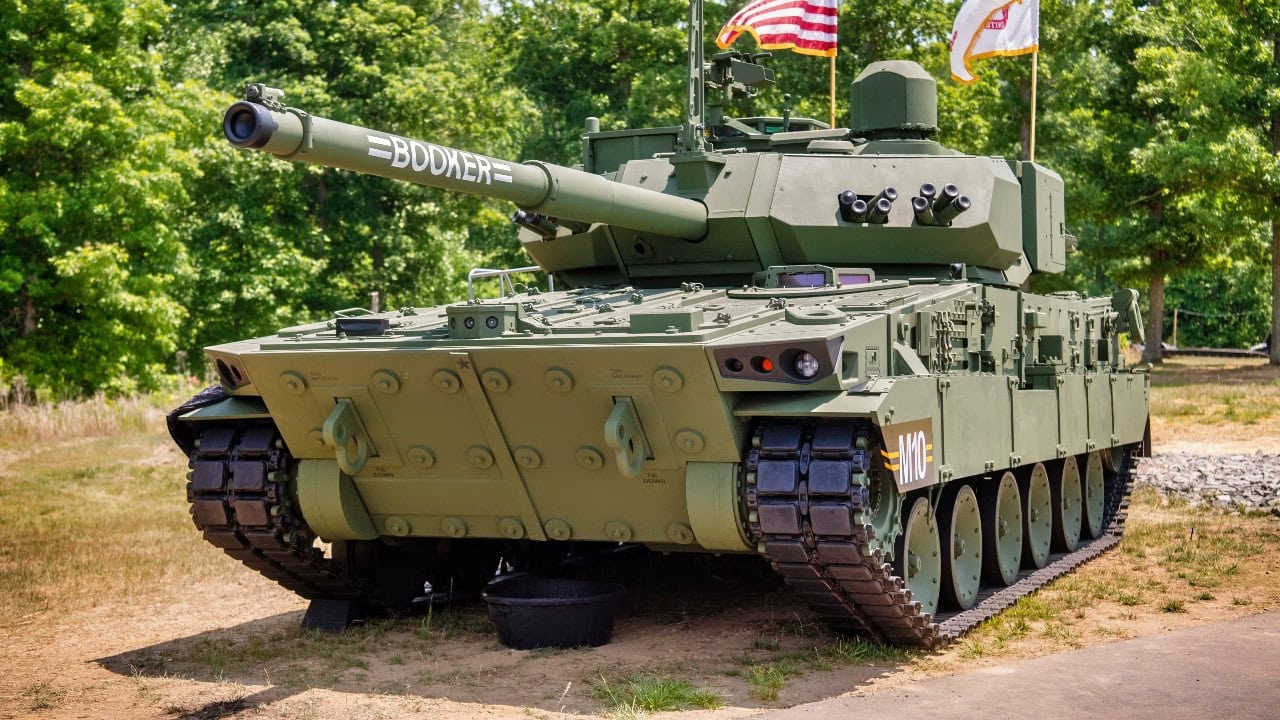The M10 Booker is dead. What was the M10 Booker?
That’s a more complicated question than you probably realize. But now, possibly because no one could figure out what it was, and US Army generals had tired of the conversation, the M10 Booker light tank (or assault gun) project has been canceled.
M10 Booker: What Was It?
Depending on your perspective, the M10 Booker was an Assault Gun, an Armored Infantry Support Vehicle, or a Light Tank. The Booker carries a 105mm turreted gun on a 40-ton armored chassis and can make about 40 miles per hour under its own power.
Named for an American tank commander who died in 2003 in Baghdad and an infantryman who won the Congressional Medal of Honor in 1943 in North Africa, the design process for the Booker began in late 2018, with the first prototype delivered in 2022. About eighty Bookers have been delivered to the US Army thus far.
Generally speaking, tanks are expected to be armored, to locomote on treads, and to have a rotating turret with a large caliber gun, all of which fit the description of the Booker. However, according to US Army General Glenn Dean, “the M10 Booker is an armored vehicle that is intended to support our Infantry Brigade Combat Teams by suppressing and destroying fortifications, gun systems and trench routes, and then secondarily providing protection against enemy armored vehicles.”
Evidently, in the view of the Army, these criteria make it Not a Tank. However, it is not unusual for light tanks (which the M10 Booker resembles visually and in size) to undertake all the abovementioned missions.
Why does this matter? The Army was likely concerned that if people started calling it a tank, it would be used for roles that tanks have traditionally undertaken (fighting other tanks, for example) rather than its intended infantry support role. Worse, mission requirements that called for the deployment of a tank might have been fulfilled by the Booker rather than by one of the Army’s heavier Abrams tanks. The rhetorical confusion speaks, however, to a broader degree of organizational confusion about the nature and purpose of the Booker project.
Why Is It Dead?
And now the Booker will be nothing. Last week, Secretary of the Army Dan Driscoll decreed the cancellation of the Booker, ending the debate with “now that we’re canceling, you can call it whatever.” According to Meghan Myers, “In this case, the Army knew early on that it wasn’t going to be able to make the thing it had set out to make, but it was bound and determined to make something. So it made something it doesn’t actually need.”
Mobility was a key requirement (the Army wanted a vehicle that could be airdropped), and the Booker rapidly became overweight. The problem came to a head when the Army realized that the vehicle was too heavy to use most of the bridges at Fort Campbell, home of the 101st Airborne. Moreover, the Army had come to regard the cost as excessive, a problem common to long-term procurement projects. A third problem involved the maintenance contract, which had attracted criticism in Congress and in the Army.
The contract with General Dynamics caused a large number of maintenance issues for the manufacturer, limiting the ability of the Army to repair the vehicles on its own and opening up the possibility of high costs later on. This ran afoul of the growing “Right to Repair” movement that sees such contracts as a means for corporations to leverage their intellectual property rights at the expense of consumers.
No one seems to know what the eighty vehicles already delivered will be used for. Most likely, they’ll be warehoused and eventually scrapped; the Army has little use for such a small fleet of vehicles, and keeping them around would create maintenance and supply chain problems. For the same reasons, a foreign sale seems unlikely.
What will fill the gap? At this point, the situation remains unclear. One option is a light Abrams variant, although getting the massive main battle tank down to a “light tank” standard will be an engineering challenge, preserving any maintenance and spare part coherence in the Abrams supply chain.
What Happens Now?
The experience of the Booker serves as a dramatic confirmation that US military procurement problems aren’t limited to the Navy or the Air Force. The Army had several opportunities over the past decade to identify the mismatch between what the Booker was supposed to be and what it ended up being.
Yet, the program continued to roll along despite serving no one’s needs. The Army remains without a light tank (or assault gun) despite an anticipated shift to the need for lighter, more deployable forces in the Pacific.
About the Author: Dr. Robert Farley
Dr. Robert Farley has taught security and diplomacy courses at the Patterson School since 2005. He received his BS from the University of Oregon in 1997, and his Ph. D. from the University of Washington in 2004. Dr. Farley is the author of Grounded: The Case for Abolishing the United States Air Force (University Press of Kentucky, 2014), the Battleship Book (Wildside, 2016), Patents for Power: Intellectual Property Law and the Diffusion of Military Technology (University of Chicago, 2020), and most recently Waging War with Gold: National Security and the Finance Domain Across the Ages (Lynne Rienner, 2023). He has contributed extensively to a number of journals and magazines, including the National Interest, the Diplomat: APAC, World Politics Review, and the American Prospect. Dr. Farley is also a founder and senior editor of Lawyers, Guns and Money.

